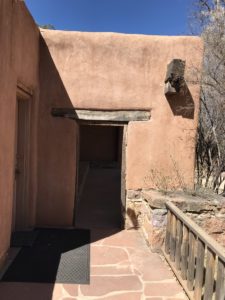On this first week we read in the “Introduction” (pages 8-11) to the Metropolitan’s guide to Islamic arts how geometry, distances, and calculations in space and designs contribute to the branding of a type of architecture. To understand and read competently the ways in which sacredness and architecture correspond with each other, we read Lang’s essay on sacredness and architecture as a point of departure to guide us both in the second kickoff of the course and in our beginning the semester.

In your reflections, you considered a piece of Lang’s argument, and gauged how visual evidence found by you supported, or not, that part of his argument on “Sacredness and Architecture.”
Please, POST here your reflection for this week. You do not have to rewrite any part of this, ONLY add the names of the two partners contributing to this reflection, so everyone knows the parties involved in the post. Thank you.

Gabe Kim
Tristen Kho
Mario Botta argues the importance of sacred condition that is out of human’s control by placing a stone on the ground level of his architecture. The structure of Cymbalista Synagogue tailors his argument by having two cylindrical-shaped buildings jointed by rectangular-shaped stone at the ground level.
According to the principle of modern structures, buildings with identical structures should serve likely identical functions. Botta, however, does not believe in “hailed principle of modern architecture that form should follow function”. Botta’s Cymbalista has two identical and cylindrical shaped buildings but they have distinct functions. One serves as a synagogue, while the other serves as a conference hall. By building the cultural center identical to the synagogue, Botta proved that all buildings could be sacred, regardless of their religious connotations. In this way, Lang attempts to present Botta in contrast to another contemporary architect, Massimiliano Fuksas, who believes that no building is innately sacred. However they both agree that church buildings do not need to distinguish themselves for their sacred functions and should be treated the same as any other form of architecture. The only position they differ is on their definition of the sacred. While Botta believes that this makes any form of architecture equal to a Church and therefore sacred, Fuksas believes that the ambiguity of the word sacred itself means that no building can be considered sacred.
Don Asafu-Adjaye
Vanessa Perez
Figure 3 refers to the image of the great staircase of the Church of Gesu. Fuksas describes the style of the building as a facade because it does not look like a traditional church from the outside. Instead, it looks like a large concrete building with multiple floors without “prominent Christian symbolism” (46). However, upon entering, one’s expectation is not met. Instead, it is one floor with a tall ceiling in the shape of a dome excessively ornamented in Christian symbolism.
The description given to the “great staircase” by Mr. Fuksas very well supports the image of Gesu because while it may initially seem as though Mr. Fuksas praises the exterior stairs of the building, he does not. Mr. Fuksas makes the stairs seem very distinguished in his description of it and use of adjectives such as “great power” in describing it, yet his use of the word “façade” gives off a different impression on the exterior of the building. The use of the word façade points out the lack of “ornamentation and prominent Christian symbols” on the church. Although in the image of the exterior of the church there are indicators that the building is purposed for Christian worship, the indicators are not pronounced enough.
It is very clear why Mr. Fuksas rejects the structure of this building. In the passage, he indicated that “the particular character of a church is expressed in the fact that it stands out.” In other words, churches should be created in such a way that the exterior of it draws attention to it being a church. With the minimal ornamentation of the Church of Gesu, it is clear that the exterior of the church does not do a very good job of distinguishing itself from other buildings that surround it. Therefore, without a doubt, the images of the Church of Gesu do support the description of the gesu and helps clarify arguments made against it.
The argument that Lang made in this section of the reading was that there are some cases in which architecture fails to express its sacredness. It was clear to us how there would be a debate on whether or not this particular cathedral would satisfy peoples’ notion or expectation of sacredness. This is because the cathedral pictured below is much more modern than the traditional medieval cathedral that so many adore and expect. Lang, being one of these people, criticizes the Los Angeles Cathedral and claims that Moneo’s (the cathedral’s architect) lack of consultation with the traditions of the Church resulted in the cathedral’s architectural failure to communicate sacredness. While Lang may disagree with the cathedral’s ability to achieve sacredness, we believe that, in spite of its non-traditional aspects (i.e. modern chandeliers, wood paneling, simple aesthetic), the architect succeeded in creating a space in which a person can be struck with awe and wonder. We believe that the cathedral is inspiring with its high ceilings, the natural light reflecting in from the sky onto the stone walls, and simply the grand scale of it all. After having studied these images, therefore, we were not in agreement with Lang’s argument that the Los Angeles Cathedral fails to be sacred architecture. In fact, we believe that the non-traditional elements add a sense of splendor and beauty to the sanctity of the space. The main issue we had with Lang’s argument was that he believed that the architect did NOT “realize the chance to leave a monument of greater and more lasting significance” because we, on the other hand, believe that the cathedral DOES have a lasting significance (58).
Ike Amechi
Ariel Brown
Lydia Ruotolo
Image:
https://en.wikiarquitectura.com/building/san-paolo-church-in-foligno/
Arguments:
The church of San Paolo in Foligno doesn’t particularly strike me as something that has much of a relationship with its exterior environment. It looks completely separate from any thought of nature due to its plain, sterile texture/building materials. However, it does stand out. Set against the backdrop of mountains, small houses, and fields, this church is extremely unique next to its surroundings. Its contemporary modeling is unlike any of the buildings around it and seems to act as a sort of focal point in the area that it’s in. Additionally, the windows themselves look erratic in comparison to the cubic shape of the building. This contrast draws the eye.
Going by the images found online, the height isn’t noticeable from the exterior. It almost looks as though the height and width are the same measurements. The images of the interior, however, are striking in this regard. The ceilings look high, and the comparison to Gothic architecture fully made sense while viewing the church from this angle. The way in which the building sort of towers from the outside is also slightly reminiscent of gothic architecture as Fuksas attempted. However, the featurelessness of the outer facade does not succeed in fulfilling the look that resembles gothic structures.
Overall, this figure does seem to provide support to the part of Lang’s argument that about churches needing to represent sacred architecture. This building could easily be seen as anything but a church without context, and that could be an issue when it comes to deciding actual uses for the building. In fact, it could make discussions about what functions the building should serve now or in the future much harder do to its lack of distinction. In general, religious buildings designed in this way could also make it easier for someone to forcibly repossess a religious building. If the building looks to be religious in some way, then it might either make such forces rethink taking away place of worship from a community of people or convince others to stand with the community to protect their sacred place.